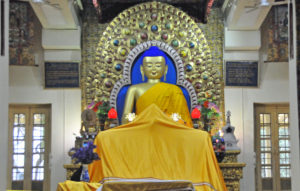
Dalai Lama’s Temple in McLeod Ganj, India (Photo by Don Knebel)
In 1939, four-year-old Lhamo Döndrub, born to a poor Tibetan farming family, was declared the 14th Dalai Lama and taken, along with his parents, to Lhasa, Tibet’s capital. Considered the reincarnation of earlier Dalai Lamas and Avalokiteśvara, the bodhisattva of compassion, Döndrub was renamed Tenzin Gyatso. At age 15, Gyatso, titled “His Holiness the Dalai Lama,” became the temporal leader of Tibet. In March 1959, during a failed revolt by Tibetans against Chinese control, the Dalai Lama and a small entourage, including his immediate family, escaped from Lhasa on foot and eventually reached extreme northeastern India. The Indian government allowed the Dalai Lama to set up a Tibetan government in exile in McLeod Ganj, a former British military town high in the mountains of northwest India that had been severely damaged by a 1905 earthquake. Thousands of Tibetan refugees followed the Dalai Lama to McLeod Ganj, which became known as “Little Lhasa.”
Today, McLeod Ganj, up a narrow road from Dharamsala, includes the modest residence of the Dalai Lama and the recently reconstructed building of the Tibetan Parliament in exile. The sobering Tibetan Museum chronicles the stories of Tibetan refugees and displays names and pictures of the more than 145 Tibetans who have self-immolated since 2009 protesting Chinese domination of their country. McLeod Ganj’s most popular building is the Dalai Lama’s private temple, where he frequently teaches, sitting on a large chair in front of a magnificent image of Buddha. To the Dalai Lama’s right is a statue of Avalokiteśvara, the patron deity of Tibet, reminding him of the compassion that is always at the heart of his message.
Comments are closed.